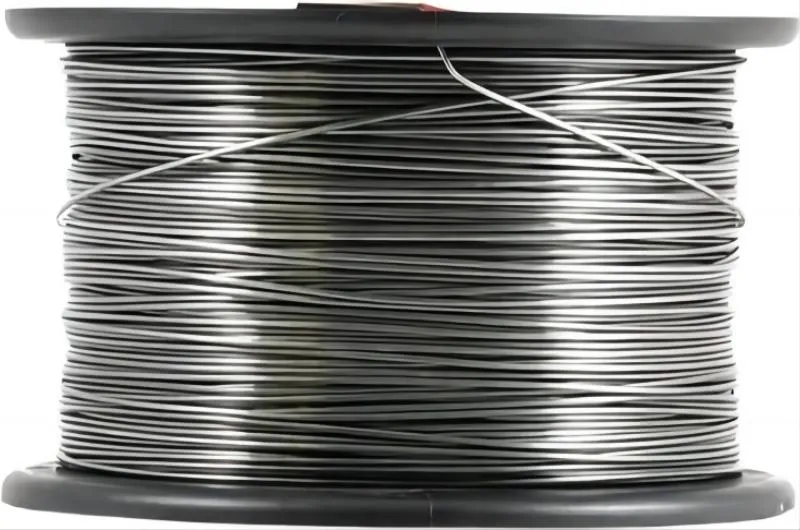BY  GENN
GENN
2024/03
Blog
Application Status And Development Trends Of Cored Wire Technology
What is Cored Wire?
Cored wire, sometimes referred to as flux-cored wire, is a particular kind of wire with uses and benefits specific to the welding process.
- Production and attributes:
The diameters of cored wires vary; common sizes over 0.8 mm include 1.2, 1.4, and 1.6 mm. The types of cored wires include alloy cored wire, calcium iron cored wire, and calcium silicate cored wire, among others.
A tubular welding wire loaded with metal powders, alloys, and arc stabilizers is called cored wire. Each of these materials has special advantages, such as lowering oxidation, increasing impact strength, and lowering silicon deposits in the finished weld.
Iron makes up the majority of the powder core in a metal core wire; different proportions of other components are added to achieve particular results, such as lowering oxidation or raising impact strength.
- Uses and benefits:
Many types of welding operations, such as joining, hard facing, repair, and maintenance welding, can use cored wire. Even in procedures where the weld pool is challenging to manage, including overhead and vertical welding situations, it permits penetration welding at high welding rates and welding in all positions.
Of all welding consumables, metal-cored wire offers one of the highest deposition rates, allowing for high deposition rates and efficiency that boost production and save costs.
Flux-cored wire does not form slag and has a greater deposition rate than solid wire for a given heat input. It is appropriate for a range of base metals and applications due to its ease of alloying and availability in a wide range of chemical compositions.
Current Application Status Of Cored Wire Technology
Part 1
When core-clad wire technology first emerged in the late 1970s, its primary objective was to add calcium to steel. Over the course of more than 30 years, it has successfully navigated this transition from non-recognition to widespread respect and limited application. to extensive marketing, from the desulfurization, spheroidization, inoculation treatment, alloying, and microalloying of molten steel to the refinement, microalloying, alloying, and modification treatment of molten iron, among other modifications. The outcome of these modifications and advancements has not only transformed the production of steel but is also increasingly contributing to the casting of grey, ductile, and vermicular iron.
With the advent of cored wire technology, many of the original uses for electric furnaces and converters in the steelmaking process have been abandoned in favor of “steel-making” instruments that are only used for dephosphorization (if necessary) or decarburization. Refinement processes like composition fine-tuning, alloying, micro-alloying, and desulfurization are all carried out outside of the melting furnace.
Part 2
The cored wire process is now more competitive than other welding procedures due to the fabrication of smaller-diameter wires with superior mechanical qualities and the ability to weld in all positions thanks to advancements in flux formulas and manufacturing technology.
Because cored wire technology offers advantages in production speed and efficiency, welding electrodes have been rapidly replaced. It offers great melting capacity, the ability to weld in any position at high current intensities, and the elimination of stops that happen at the end of each electrode.
A low-carbon, low-sulfur steel sheath that firmly encases powdered metals, minerals, and ferroalloys is used to create the cored wire. Every coil has constant chemistry and density along its whole length thanks to this exacting production procedure. Additionally, the technology has been refined for wire injection and calcium-wire treatment, providing an affordable in-ladle treatment option.
A particular kind of cored wire called metal-cored wire has found use in the manufacture of heavy machinery and agricultural equipment, automobile exhaust systems, and railcars. Applications requiring a large quantity of out-of-position welding should avoid using it.
In applications like vertical up welding, flux-cored wires—which are often made with a large proportion of iron powder in their fill—allow for high deposition rates. All industry segments are using and using flux-cored and metal-cored wires more frequently because of their high deposition rates and good arc performance.
To sum up, cored wire technology has advanced significantly and is now used in a wide range of industries. Its advantages include increased weld quality, high melting capacity, and production efficiency.
Advantages and Disadvantages Of Cored Wire
It is important to understand the advantages and disadvantages of cored wire to have a better understanding of its application.
The flux-cored wires are extremely easy and convenient to use for most types of welding applications. They are mostly contaminant-free, which makes the welding durable. The wire can also be used with multiple alloys, depending on the base metal.
The disadvantage, however, is the deposition of slag during welding, which the operator has to remove once the welding is done. The use of flux-cored wires can also be expensive compared to using solid wires.










